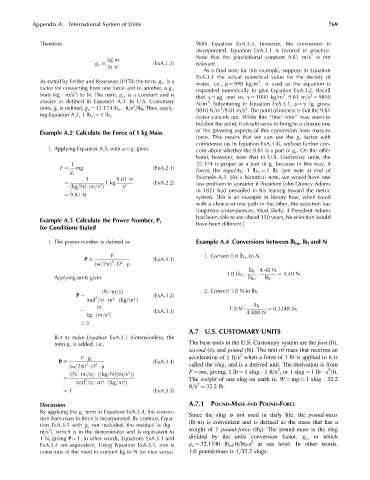Page 814 - Fundamentals of Water Treatment Unit Processes : Physical, Chemical, and Biological
P. 814
Appendix A: International System of Units 769
Therefore With Equation ExA.3.4, however, the conversion is
incorporated. Equation ExA.3.1 is favored in practice.
Note that the gravitational constant 9.81 m=s 2 is not
kg m
(ExA:1:2) relevant.
N s
g c 2
As a final note for this example, suppose in Equation
ExA.3.1 the actual numerical value for the density of
As stated by Felder and Rousseau (1978) the term, g c ,is a water, i.e., r ¼ 998 kg=m , is used as the equation is
3
factor for converting from one force unit to another, e.g., expanded numerically to give Equation ExA.3.2. Recall
2
from (kg m=s ) to N. The term, g c , is a constant and is that g ¼ rg, and so, g ¼ 1000 kg=m 9.81 m=s ¼ 9810
2
3
always as defined in Equation A.3. In U.S. Customary N=m . Substituting in Equation ExA.3.1, r ¼ g =g, gives,
3
2
units, g c is defined, g c ¼ 32.174 lb m ft=s =lb f . Thus, apply- 3 2
9810 N=m =9.81 m=s . The point of interest is that the 9.81
ing Equation A.3, 1 lb m ¼ 1lb f .
factor cancels out. While this ‘‘final note’’ may seem to
belabor the point, it should serve to bring to a closure one
of the gnawing aspects of this conversion from mass to
Example A.2 Calculate the Force of 1 kg Mass
force. This means that we can use the g c factor with
confidence (as in Equation ExA.3.4), without further con-
1. Applying Equation A.3, with a ¼ g, gives cern about whether the 9.81 is a part of g c . On the other
hand, however, note that in U.S. Customary units, the
1 32.174 is proper as a part of g c because in this way, it
mg (ExA:2:1)
F ¼ forces the equality, 1 lb m ¼ 1lb f (see note at end of
g c
1 9:81 m Example A.1. [As a historical note, we would have one
1kg (ExA:2:2)
2 s 2
¼ less problem to consider if President John Quincy Adams
ð
ð kg=NÞ m=s Þ
in 1821 had prevailed in his leaning toward the metric
¼ 9:81 N
system. This is an example in history how, when faced
with a choice of one path or the other, the selection has
long-term consequences. Most likely, if President Adams
had been able to see ahead 150 years, his selection would
Example A.3 Calculate the Power Number, P,
have been different.]
for Conditions Stated
1. The power number is defined as Example A.4 Conversions between lb m ,lb f and N
P 1. Convert 1.0 lb m to N,
P 3 5 (ExA:3:1)
v=2pÞ D r
ð
lb f 4:48 N
¼ 4:48 N
Applying units gives 1:0lb m lb m lb f
2. Convert 1.0 N to lb f ,
(ExA:3:2)
ð N m=sÞ
3 5 3
P ¼
(rad =s) m kg=mð Þ
N lb f
(ExA:3:3) 1:0N ¼ 0:2248 lb f
2
¼ 4:448 N
ð
kg m=s Þ
¼ 1
A.7 U.S. CUSTOMARY UNITS
But to make Equation ExA.3.1 dimensionless, the
term g c is added, i.e., The base units in the U.S. Customary system are the foot (ft),
second (s), and pound (lb). The unit of mass that receives an
2
acceleration of 1 ft=s when a force of 1 lb is applied to it is
P g c
P 3 5 (ExA:3:4) called the slug, and is a derived unit. The derivation is from
v=2pÞ D r
ð 2 2
2 F ¼ ma, giving, 1 lb ¼ 1 slug 1ft=s , or 1 slug ¼ 1lb s =ft.
ð (N m)=sÞ kg=NÞ m=s ÞÞ
ð
ð
ð
¼ 3 5 3 The weight of one slug on earth is, W ¼ mg ¼ 1 slug 32.2
ft=s ¼ 32.2 lb.
(rad =s) m kg=mð Þ 2
¼ 1 (ExA:3:5)
Discussion A.7.1 POUND-MASS AND POUND-FORCE
By applying the g c term in Equation ExA.3.4, the conver-
Since the slug is not used in daily life, the pound-mass
sion from mass to force is incorporated. By contrast, Equa-
(lb-m) is convenient and is defined as the mass that has a
tion ExA.3.1 with g c not included, the residual is (kg
2
m=s ), which is in the denominator and is equivalent to weight of 1 pound-force (lb f ). The pound-mass is the slug
1 N, giving P ¼ 1. In other words, Equations ExA.3.1 and divided by the units conversion factor, g c , in which
ExA.3.4 are equivalent. Using Equation ExA.3.1, one is g c ¼ 32.1740 lb m -ft=lb f -s 2 at sea level. In other words,
conscious of the need to convert kg to N (or vice versa). 1.0 pound-mass is 1=32.2 slugs.

